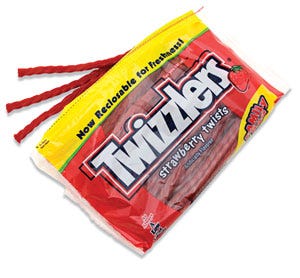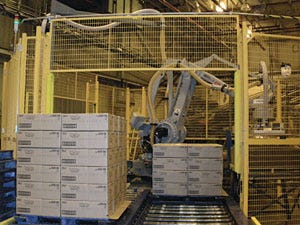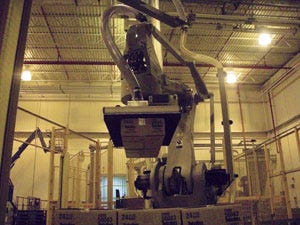Candy factory modernizes its robotic-palletizing

Hershey Company's Robotic Palletizing 2
Since April 2009, the Y&S Candies plant in Lancaster, PA, home of the Twizzler, has been upgrading its four 20-yr-old robotic case-palletizing cells, replacing aging robots with new, state-of-the-art Motoman Inc. models designed for palletizing applications.While the project originally was specified as a straight obsolete-equipment replacement for Y&S, a division of The Hershey Co., the robot upgrade has made several significant improvements to the plant's palletizing operations, including improved productivity.
“We've seen an increase in speed of as much as 20 percent, from eight cases/min to 10 cases/min,” says Hershey senior packaging-systems engineer and project manager Alex Diaz.
“The new Motoman EPL160 four-axis robots execute their moves more quickly than did the older robots, with quicker acceleration. We get faster picks and drops and dropped-case incidents are few and far between now, thanks to a new end effector specified with the robots that handles our larger and heavier cases more reliably.”
The four robots at Y&S are arranged in two groups of two each, and each robot will handle cases from up to four packaging lines simultaneously, depending on the case sizes.
Fitting new robots into existing cells
Diaz belongs to a team of packaging-system engineers employed out of The Hershey Co. Global Operations Engineering Div. Diaz, along with Andrew Brighton, staff engineer at the Y&S plant, decided early in 2008 to replace the aging robots at Y&S with newer Motoman EPL models.
EPL160 robots (160-kg payload) offer a 124.4-in. horizontal reach and use through-arm cable routing to maximize cable life while serving multiple infeed conveyors and pallet stations. The robot's utilities-management package features 23 wires for communication and six internally routed air lines for end-of-arm tooling.

Hershey Company's Robotic Palletizing 3
This setup eliminates pinch points and potential interference with other equipment in the workcell, improving flexibility and minimizing downtime. The robot's vertical reach is 119.1 in., and position repeatability is +/- 0.5 in.
The four robotic palletizing cells at Y&S pick cases from infeed conveyors fed by a main conveyor trunk line coming from the plant's packaging lines. Cases of the firm's candy products—Twizzlers, Nibs, etc.—range in size from 3.1x5.3x9.9 in. to 15.1x16.4x26.5 in. and weigh as much as 62.2 lb. Of the 149 active SKUs in use, 125 are column-stacked patterns and 24 have the top layer rotated 180 deg to interlock the load.
All receive a base slipsheet on each empty pallet, and 17 receive an intermediate slipsheet—all handled by the robots. Among the specifications Motoman received from Diaz was the requirement that the systems must be able to pick and place one to four cases, or a slip-sheet, in 8.5 to 9.0 sec.
Customized software
“The palletizing operation uses 52 different pallet patterns based on specific customer requirements,” Diaz explains, “and the plant creates new patterns several times per year. “With the robot upgrade, we also integrated new offline palletizing-simulation software that allows the engineers to create a new pallet pattern in as little as 10 minutes.
“And, the operator can change from one palletizing pattern to the other in less than one minute by selecting a new SKU for each lane from the control panel,” he adds.
One operator/shift oversees operation of all four of the robotic-palletizing cells, which run around the clock, and handle 85 percent of the Y&S plant's palletizing workload.

Hershey Company's Robotic Palletizing 3
Motoman's palletizing software creates a new pallet-pattern algorithm that is used by the robot to automatically calculate the build path. The software is stored on a central PC that serves all of the robots at Y&S and uploads the jobs to each robot when the robot requests a new pattern.
Using the software, Y&S engineers can quickly apply changes to box and pallet size, as specified by the customer, allowing quick and automatic generation of a new pallet program. The box sizes that the robot uses to calculate the patterns are stored in each customer's SKU database. When the robot begins to run a new pattern, it downloads the box dimensions, instructions for layer rotation and the location of slip sheets, as well as any special build instructions from the PC.
The download process takes six seconds/pattern. The software then can model interferences and run palletizing simulations to check for any interference or mistakes that may have been made during the setup of a new pattern by the operator. If the simulation looks good, the customer is assured that the robot will run the pattern problem-free. The palletizing system can handle as many as 30 layers and approximately 100 cases/layer.
Motoman engineers Mark Gleadle and Greg Morgan developed the software for the plant's unique conveyor configuration. Says Diaz, “Our conveyors were designed to enter each palletizing cell at a 15-degree angle, rather than the standard cell layout, where the conveyors typically transfer at 90 degrees from the main conveyor. Also, the outfeed conveyors were only 12 inches apart, which did not allow much room to build the pattern.”
“We challenged Motoman to make the robots work in our existing cells,” adds Diaz, “and there were some challenges there. This required them to customize the programming and palletizing software and also to engineer a custom base for each of the robots.

Hershey Company's Robotic Palletizing 4
“This new base allows the robots to sit on our standard pedestal within each cell and still reach where they need to in order to pick the cases and stack the pallets. Now, thanks to the custom software, we have more flexibility as to how we set up the end effector as well as the pick points and angles,” he explains.
All 52 of the Y&S plant's existing pallet patterns already have been reprogrammed for use by the new Motoman NX100 robot controllers that direct each robot. Motoman converted 30 of the programs and Y&S engineers handled the rest. The NX100 controller features a Windows CE programming pendant, and offers as many as 100 user passwords in four security levels—user, editor, maintenance and supervisor. Engineers can set the passwords to restrict and log changes made to production programs.
It's all in the grip
The end effector Diaz specified for each of the four new robots is the UniGripper, a universal, multipurpose vacuum tool from Swedish supplier Tepro Machine & Pac System. Specific vacuum areas of the tool are activated, based on the required shape and location of the cases, as programmed into the software. This allows Y&S to use one end effector to handle all of its package sizes, picking up anywhere from one to four cases, depending on the pattern specified.
“Also, we find that the tool, which is one large, foam-covered plate, seals to the boxes much more effectively than did the suction-cup tooling used previously,” says Diaz. “That allows the robots to more reliably handle the bigger and heavier cases without having to slow down, as they previously were required to do.” The tool can pick up two or three of the plant's heaviest cases at one time. The previous vacuum-cup end effectors could only grab one case at a time.
Along with the new robots at Y&S came a new package of safety apparatus so that the robotic cells meet ANSI/RIA 15.06-1999 safety requirements. Each cell includes 10-ft-tall, woven-wire fencing, two access gates and two self-muting light curtains that guard the pallet-conveyor discharge locations.
More information is available: |
Motoman Inc., 937/847-3200. www.motoman.com |
Tepro Machine & Pac System, +46 560 27270. www.tepro.nu |
About the Author(s)
You May Also Like


